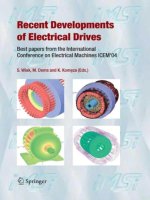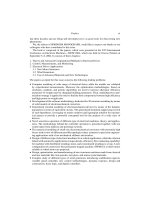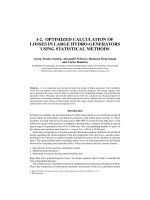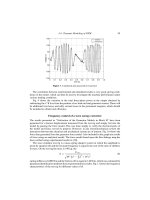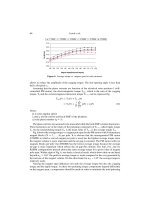Recent Developments of Electrical Drives - Part 27 ppt
Bạn đang xem bản rút gọn của tài liệu. Xem và tải ngay bản đầy đủ của tài liệu tại đây (444.83 KB, 10 trang )
II-10. Impact of Magnetic Saturation of Induction Motor 253
Taking into account equations (18), the position controller and the rotor flux linkage
controller are given by (19).
v
α
= k
α0
e
1
+ k
α1
˙
e
1
+ k
α2
¨
e
1
+ y
···
∗
1
v
β
= k
β1
e
2
+ k
β2
˙
e
2
+
¨
y
∗
2
(19)
After inserting (19) in the linearized system (15), the tracking error dynamics of the
closed loop system is given by (20)
e
···
1
+ k
α2
¨
e
1
+ k
α1
˙
e
1
+ k
α0
e
1
= 0
¨
e
2
+ k
β2
˙
e
2
+ k
β1
e
2
= 0
(20)
with k
(
·
)
being positive constants. The desired dynamics of the tracking errors e
1
and e
2
is
assured by selecting the corresponding eigenvalues λ
(
·
)
of the characteristic equations (21).
λ
3
+ k
α2
λ
2
+ k
α1
λ + k
α0
= 0
λ
2
+ k
β2
λ + k
β1
= 0 (21)
Observer design
The state variables of the selected IM model are necessary to realize control, based on
the described input-output linearization. The corresponding observer, similar to the one
presented in [15], is given by (22). It is based on the electromagnetic subsystem of the
two-phase i
s
, Ψ
r
state-space IM model (3) in the αβ reference frame. The coefficients k
(
·
)
are determined in the literature [14].
d
dt
⎡
⎢
⎢
⎢
⎣
ˆ
i
sα
ˆ
i
sβ
ˆ
ψ
rα
ˆ
ψ
rβ
⎤
⎥
⎥
⎥
⎦
= (C +ω
r
W)
⎡
⎢
⎢
⎢
⎣
ˆ
i
sα
ˆ
i
sβ
ˆ
ψ
rα
ˆ
ψ
rβ
⎤
⎥
⎥
⎥
⎦
+ D
u
sα
u
sβ
+
⎡
⎢
⎢
⎢
⎣
k
1
−ω
r
k
2
−ω
r
k
2
k
1
k
3
−ω
r
k
4
−ω
r
k
4
k
3
⎤
⎥
⎥
⎥
⎦
ˆ
i
sα
ˆ
i
sβ
−
i
sα
i
sβ
(22)
The symbol
(
ˆ·
)
denotes the observed values.
Experimental results
The experiments have been performed to test the proposed input-output linearizing tracking
control. The elements of the experimental system are the three-phase Semikron IGBT
inverter, the three-phase 3 kW IM Sever with wound rotor, whose parameters are given in
AppendixC,andtheDCmotorMavilorMo2000withan InfranorDCpowerconverter,asthe
dynamic load. The control algorithm was executed on the dSPACE DS1103 microcontroller
board. A block diagram of the proposed IM drive’s tracking control that includes magnetic
saturation is presented in Fig. 2.
Experiments were done using the reference value
2∗
r
= 1.6
(
Vs
)
2
. The smooth refer-
ence trajectories for the position θ
r
and the speed ω
r
were generated from the kinematic
model and are shown in Figs. 3(a) and 4(a). The step changes of the load torque t
l
vs. time
are shown in Fig. 3(d). The results of the input-output linearizing tracking control with the
included saturation were compared with the results obtained with the same type of control
VSI
Encoder
E (x)
−1
D(x)
Observer
Inductances
calculation
(saturation)
Load torque
estimator
T(x)
Control
IM
(y
1
, y
1
,y
1
, y
1
)*
(y
2
, y
2
,y
2
)*
-
-
v
sβ
u
sβ
u
2
2
3
3
sα
v
sα
ω
r
i
a
i
b
i
c
−
Figure 2. Block diagram of the IM’s input-output linearizing tracking control.
Figure 3. Reference and measured rotor position trajectory
∗
r
and
r
: (a) saturation is not included,
(b) saturation is included, (c) difference
r
=
∗
r
−
r
without and with saturation, and (d) load
torque t
l
.
II-10. Impact of Magnetic Saturation of Induction Motor 255
Figure 4. Reference and measured rotor speed trajectory ω
∗
r
and ω
r
: (a) saturation is not included, (b)
saturation is included, and (c) difference ω
r
= ω
∗
r
− ω
r
without and with saturation.
without included saturation [11]. The settings of the controllers were equal in both cases:
k
α0
= 750,000, k
α1
= 25,000, k
α2
= 275, k
β1
= 90,000, and k
β2
= 600.
An analysis of the results showed that the position error θ
r
in Fig. 3 and the rotor
speed error ω
r
in Fig. 4 are considerably smaller when magnetic saturation is included in
the control algorithm, observer, and load torque estimator than in the case when magnetic
saturation is neglected.
It is obvious from the results in Fig. 5 that tracking control with the included magnetic
saturation performed the position task with a slightly higher stator current i
s
=
i
2
sα
+i
2
sβ
,
than the one without saturation. In contrast, tracking control without any included mag-
netic saturation required smaller stator current to perform the same task at no-load, but it
responded with a much higher increase in stator current i
s
, when the motor was loaded with
step changes of the load torque (Fig. 5a).
The reason for the described behavior of the controlled IM in Fig. 5 can be explained if
the controlled system is analyzed together with the observer and, if only for explanation, the
stator currents i
sα
, i
sβ
are transformed to the common dq reference frame, i.e. to the stator
currents i
sd
, i
sq
(Fig. 6). The observer of electromagnetic state variables, with included
magnetic saturation yields a smaller rotor flux linkage module
r
for equal stator current
value than the linear observer introduced in [15]. Accordingly, the input-output linearizing
tracking control with included magnetic saturation increases the magnetizing stator current
i
sd
in the direction of the rotor flux linkage vector, to achieve the reference value of the
rotor flux linkage module. Therefore, the IM with the proposed input-output linearizing
control is going to be magnetized in the best possible way to ensure the proper stiffness
and optimal dynamic response. When the step changes of the load torque are applied on
256 Dolinar et al.
Figure 5. Stator currents i
sα
, i
sβ
, and i
s
=
i
2
sα
−i
2
sβ
: (a) saturation is not included and
(b) saturation is included.
the shaft, the input-output linearizing control with included magnetic saturation performs
much better than the control with neglected saturation, requiring smaller stator current
i
sq
to produce the necessary torque with the rotor flux linkage vector. The transformed
currents are shown in Fig. 6. The measured stator current i
sd
in the case of the input-output
linearizing tracking control with and without included magnetic saturation agrees with the
corresponding value of i
sd
determined from the nonlinear andlinearized magnetizing curve
of the IM, used in the observer with and without included magnetic saturation (Fig. C1,
Appendix C).
Figure 6. Stator currents i
sd
and i
sq
.
II-10. Impact of Magnetic Saturation of Induction Motor 257
Conclusion
Consideration of magnetic saturation in the IM model substantially improves its accuracy,
leading to a more efficient and consistent synthesis of the control algorithm, observer, and
estimator of load torque. The proposed input-output linearizing control of IM with included
magnetic saturation improves the dynamic performance of the drive. It gives smaller rotor
position and speed errors, as well as a higher stiffness and a better load torque rejection,
which results in a smaller stator current, when the load torque is introduced. An important
reason for the improved behavior of the controlled IM is more adequately calculated value
of the rotor flux linkage when magnetic saturation is considered in the observer design.
Appendix A
Elements of matrices C, Z, W, D
L
im
= L
2
l
− L
l
L
2
rl
1
L
rl
+ L
m
+
1
L
rl
+ L
+
L
¸
4
rl
(
L
rl
+ L
m
)(
L
rl
+ L
)
c
11
=−
1
L
im
R
s
L
l
−
L
2
rl
L
+ R
r
L
m
L
r
L
l
− L
2
rl
1
L
rl
+ L
m
+
1
L
rl
+ L
−
L
sl
L
rl
L
dd
+
L
3
rl
(
L
rl
+ L
m
)(
L
rl
+ L
)
c
12
=
1
L
im
R
s
L
2
rl
L
dq
− R
r
L
m
L
r
L
sl
L
rl
L
d
q
c
13
=
1
L
im
R
r
L
r
L
l
− L
2
rl
1
L
rl
+ L
m
+
1
L
rl
+ L
−
L
sl
L
rl
L
dd
+
L
3
rl
(
L
rl
+ L
m
)(
L
rl
+ L
)
c
14
=−
1
L
im
R
r
L
r
L
sl
L
rl
L
dq
, c
21
= c
12
, c
23
= c
14
c
22
=−
1
L
im
R
s
L
l
−
L
2
rl
L
dd
+ R
r
L
m
L
r
L
l
− L
2
rl
1
L
rl
+ L
m
+
1
L
rl
+ L
−
L
sl
L
rl
L
+
L
3
rl
(
L
rl
+ L
m
)(
L
rl
+ L
)
c
44
=−
R
r
L
r
= c
33
c
24
=
1
L
im
R
r
L
r
L
l
− L
2
rl
1
L
rl
+ L
m
+
1
L
rl
+ L
−
L
sl
L
rl
L
+
L
3
rl
(
L
rl
+ L
m
)(
L
rl
+ L
)
c
31
= R
r
L
m
L
r
= c
42
, c
33
=−
R
r
L
r
= c
44
, c
42
= R
r
L
m
L
r
= c
31
258 Dolinar et al.
z
12
=
1
L
im
L
l
−
L
2
rl
L
r
L
l
−
L
2
rl
L
z
13
=−
1
L
im
L
m
L
r
L
2
rl
L
dq
+
L
sl
L
rl
L
dq
z
21
=−
1
L
im
L
l
−
L
2
rl
L
r
L
l
−
L
2
rl
L
dd
, z
22
= z
11
z
14
=−
1
L
im
−
L
m
L
r
L
l
−
L
2
rl
L
+
L
l
− L
2
rl
1
L
rl
+ L
m
+
1
L
rl
+ L
−
L
sl
L
rl
L
dd
+
L
3
rl
(
L
rl
+ L
m
)(
L
rl
+ L
)
z
23
=−
1
L
im
L
m
L
r
L
l
−
L
2
rl
L
dd
+
−L
l
+ L
2
rl
1
L
rl
+ L
m
+
1
L
rl
+ L
+
L
sl
L
rl
L
−
L
3
rl
(
L
rl
+ L
m
)(
L
rl
+ L
)
z
24
= z
13
, z
34
= 1, z
43
=−1, w
13
=
1
L
im
L
sl
L
rl
L
dq
, w
13
=
1
L
im
L
sl
L
rl
L
dq
w
14
=
1
L
im
L
l
− L
2
rl
1
L
rl
+ L
m
+
1
L
rl
+ L
−
L
sl
L
rl
L
dd
+
L
3
rl
(
L
rl
+ L
m
)(
L
rl
+ L
)
w
23
=−
1
L
im
L
l
− L
2
rl
1
L
rl
+ L
m
+
1
L
rl
+ L
−
L
sl
L
rl
L
+
L
3
rl
(
L
rl
+ L
m
)(
L
rl
+ L
)
w
24
=−w
13
, w
34
=−1, w
43
= 1
d
11
=
1
L
im
L
l
−
L
2
rl
L
, d
12
=
1
L
im
L
2
rl
L
dq
d
21
= d
12
, d
22
=
1
L
im
L
l
−
L
2
rl
L
dd
Appendix B
Lie derivatives
L
3
f
φ
1
=
∂
∂x
L
2
f
φ
1
dx
dt
=∇
L
2
f
φ
1
[
f + Gu
]
= p
L
m
L
r
1
J
c
22
+ c
33
−
f
J
i
sβ
ψ
rα
−
c
11
+ c
44
−
f
J
i
sα
ψ
rβ
+c
12
i
sα
ψ
rα
−i
sβ
ψ
rβ
− ω
r
i
sα
ψ
rα
+i
sβ
ψ
rβ
+
(
c
24
+ c
13
− 2w
13
ω
r
)
ψ
rα
ψ
rβ
+
(
c
23
+ w
23
ω
r
)
ψ
2
rα
−
(
c
14
+ w
14
ω
r
)
ψ
2
rβ
+
f
J
2
t
l
+
f
2
J
2
ω
r
L
2
f
φ
2
=
∂
∂x
L
f
φ
2
dx
dt
=∇
L
f
φ
2
[
f + Gu
]
= 2R
r
L
m
L
r
c
11
+ c
33
− 2
c
31
L
m
i
sα
ψ
rα
+
c
22
+ c
44
− 2
c
31
L
m
i
sβ
ψ
rβ
II-10. Impact of Magnetic Saturation of Induction Motor 259
+c
12
i
sβ
ψ
rα
+i
sα
ψ
rβ
+ ω
r
i
sβ
ψ
rα
−i
sα
ψ
rβ
+
(
c
14
+ c
23
+ w
14
ω
r
+ w
23
ω
r
)
ψ
rα
ψ
rβ
+
c
13
− 2
c
33
L
m
ψ
2
rα
+
c
24
− 2
c
33
L
m
ψ
2
rβ
+ w
31
ω
r
ψ
2
rα
− ψ
2
rβ
+ c
31
i
2
sα
+i
2
sβ
L
gα
L
2
f
φ
1
=
∂
∂x
L
f
φ
1
g
α
= p
L
m
L
r
1
J
d
21
ψ
rα
− d
11
ψ
rβ
L
gβ
L
2
f
φ
1
=
∂
∂x
L
f
φ
1
g
β
= p
L
m
L
r
1
J
d
22
ψ
rα
− d
12
ψ
rβ
L
gα
L
f
φ
2
=
∂
∂x
L
f
φ
2
g
α
= 2R
r
L
m
L
r
d
11
ψ
rα
+ d
21
ψ
rβ
L
gβ
L
f
φ
2
=
∂
∂x
L
f
φ
2
g
β
= 2R
r
L
m
L
r
d
12
ψ
rα
+ d
22
ψ
rβ
Appendix C
Table 1. Parameters of the 3 kW induction motor with wound rotor Sever ZPD112MK4:
R
s
1.976
L
m
0.223 H
L
s
0.2335 H
f 0.0007 Nms/rad
R
r
2.91
L
r
0.2335 H
J 0.031 kgm
2
T
n
15 Nm
Figure C 1. Rotor flux linkage and corresponding stator current in the case of linear and nonlinear
magnetizing curve.
260 Dolinar et al.
Acknowledgment
This work was supported in part by the Slovene Ministry of Education, Science and Sport,
Project No. P2-0115.
References
[1] P. Vas, Electrical Machines and Drives: A Space-Vector Theory Approach, Oxford: Oxford
University Press, 1992.
[2] J.C. Moreira, T.A. Lipo, Modelling of saturated ac machines including air gap flux harmonic
components, IEEE Trans. Ind. Appl., Vol. 28, No. 2, pp. 343–349, 1997.
[3] E. Levi, A unified approach to main flux saturation modelling in d-q axis models of induction
machines, IEEE Trans. Energy Convers., Vol. 10, No. 3, pp. 455–461, 1995.
[4] E. Levi, Impact of cross-saturation on accuracy of saturated induction machine models, IEEE
Trans. Energy Convers., Vol. 12, No. 3, pp. 211–216, 1997.
[5] R.D.Lorenz, D.W. Novotny,Saturation effects infield-orientedinduction machines, IEEETrans.
Ind. Appl., Vol. 26, No. 5, pp. 283–289, 1990.
[6] E. Levi, S. Vukosav´ıc, V. Vuˇckov´ıc, “Saturation Compensation Schemes for Vector Controlled
Induction Motor Drives”, PESC’90 Record, San Antonio, TX, USA, pp. 591–598, 1990.
[7] P. Vas, Sensorless Vector and Direct Torque Control, Oxford: Oxford University Press, 1998.
[8] E.Levi, M. Sokola, S.N. Vukosav´ıc, A method for magnetizing curve identification in rotor flux
oriented induction machines, IEEE Trans. Energy Convers., Vol. 15, No. 2, pp. 157–162, 2000.
[9] Z. Krzeminski, A. Jaderko, “A Speed Observer System of Induction Motor with Magnetizing
Curve Identification”, EPE-PEMC 2000, Kosice, Slovakia, 2000.
[10] Z. Krzeminski, “Nonlinear Control of Induction Motor”, Proc. 10th IFAC World Congress,
Munchen, Germany, 1987, pp. 349–354.
[11] R. Marino, S. Peresada, P. Valigi, Adaptive nonlinear control of induction motors via extended
matching, Lect. Note Contr. Inform. Sci., Vol. 160, pp. 1435–1454, 1991.
[12] T. von Raumer, J.M. Dion, L. Dugard, “Adaptive Nonlinear Speed and Torque Control of IM”,
Proceedings of European Control Conference, Gronigen, June 1993, pp. 592–596.
[13] R.T. Novotnak, J. Chiasson, M. Bodson, High-performance motion control of an induction
motor with magnetic saturation, IEEE Trans. Contr. Syst. Technol., Vol. 7, No. 3, pp. 315–327,
1999.
[14] P. Ljuˇsev, “Analysis of Induction Motor Control Taking into Account Magnetic Saturation”,
Master thesis, University of Maribor, Slovenia, 2002.
[15] G.C.Verghese, S.R. Sanders, Observersforflux estimation in inductionmachines,IEEE Trans.
Ind. Electron., Vol. 35, No. 1, pp. 85–94, 1988.
II-11. DIRECT POWER AND TORQUE
CONTROL SCHEME FOR SPACE
VECTOR MODULATED AC/DC/AC
CONVERTER-FED INDUCTION MOTOR
M. Jasinski, M. P. Kazmierkowski and M. Zelechowski
Warsaw University of Technology, Institute of Control & Industrial Electronics,
ul. Koszykowa 75, 00-662 Warszawa,
, ,
WWW: />Abstract. A novel control scheme for PWM rectifier-inverter system is proposed. Fast control strate-
gies such as line voltage Sensorless Virtual Flux (VF) based Direct Power Control with Space Vector
Modulator (DPC-SVM) for rectifier and Direct Torque Control with Space Vector Modulator (DTC-
SVM) for inverter side are used. These strategies lead to good dynamic and static behaviour of the
proposed control system—Direct Power and Torque Control- Space Vector Modulated (DPTSVM).
Simulations and experiment results obtained show good performance of the proposed system. Addi-
tional power feedforward loop from motor to rectifier control side improved dynamic behaviours of
the power flow control. As a result, better input-output energy matching allows decreasing the size of
the dc-link capacitor
Introduction
The adjustable speed drives (ASD) with diode rectifier nowadays is the most popular on
the marked. Large electrolytic capacitor is used as an energy-storing device to decouple
rectifier and the inverter circuits. The capacitors have some drawbacks: low reliability, high
size, weight and cost. Hence, reliability of the dc-link capacitor is the major factor limiting
the lifetime of the ASD systems [1].
Development of control methods for Pulse Width Modulated (PWM) boost rectifier
(active rectifier) was possible thanks to advances in power semiconductors devices and
Digital Signal Processors (DSP). Therefore, the Insulated Gate Bipolar Transistors (IGBT)
AC/DC/AC converter controlled by PWM is used in motor drive systems (Fig.1). Thanks to
active rectifier the dc-link capacitor can be reduced [2]. Farther reduction of the capacitor
can be achieved by power feedforward loop from motor side to the control of the PWM
rectifier. A lot of works are given attention to reduce the dc-link capacitor. However, a small
capacitance leadstoahighdc-voltage fluctuation. Toavoid thisdrawback variousdc-voltage
control schemes have been proposed. Some of them take into account the inverter dynamics
S. Wiak, M. Dems, K. Kom
˛
eza (eds.), Recent Developments of Electrical Drives, 261–274.
C
2006 Springer.
262 Jasinski et al.
Figure 1. Representation of three-phase PWM rectifier—inverter system; vector diagram and coor-
dinate system for: a) PWM rectifier side b) inverter side.
to improve the PWM rectifier current control by feedback linearization [3] and master-slave
[1] manner. Another control methodology proposed a fast dc-link voltage controller which
works with dc-voltage and motor variables as inputs [4]. Moreover, various methods of the
output power estimation have been discussed in [5].
In the mentioned methods active and reactive powers of the PWM rectifier are indirectly
controlled via current control loops. Besides, stator current controllers control the torque
and flux of the motor too.
In this paper a line voltage sensorless Virtual Flux (VF) based Direct Power Control with
Space Vector Modulator (DPC-SVM) is applied to control of the PWM rectifier.
The inverter with induction motor is controlled via Direct Torque Control with Space
VectorModulator(DTCSVM).Contrar y tothescheme proposedin[6], oursolutionincludes
not stator flux controller but space vector modulator.
Hence, an AC/DC/AC converter of Fig. 1, is controlled by Sensorless Direct Power and
Torque Control-Space Vector Modulated (DPT-SVM) scheme. In comparison to methods
that control an active and reactive power, torque and flux in indirect manner the coordinates
transformation and decoupling are not required. Moreover, the current control loops are
avoided.
In respect of dynamic, of dc-voltage control the power balance between line and motor
is very important. Therefore, to improve instantaneous input/output power matching, the
additional feedforward power control loop is introduced.
Thanks to better control of the power flow the fluctuation of the dc-link voltages will be
decrease. So the size of the dc-link capacitor can be reduced.

